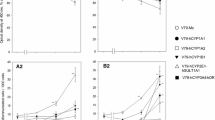Abstract
The effects of three polychlorinated biphenyl (PCB) congeners and their six methylsulfonyl (MeSO2)-metabolites on cell communication have been investigated in the scrape-loading/dye-transfer assay in IAR 20 rat liver epithelial cells. The results demonstrated that at non-cytotoxic concentrations 2,2′,4′,5-tetrachlorobiphenyl, 2,2′,4′,5,5′-pentachlorobiphenyl (2,2′,4′,5,5′-pentaCB), 2,2′,4′,5,5′,6-hexachlorobiphenyl (2,2′,4′,5,5′, 6-hexaCB), and their 3- and 4-MeSO2 derivatives completely inhibited the cell communication within 1 h. 4-MeSO2-2,2′,4′,5,5′-pentaCB and 4-MeSO2-2,2′,4′,5, 5′,6-hexaCB appeared to inhibit the cell communication at slightly lower concentration than their parental PCB congeners and 3-MeSO2 derivatives. The results show that 3- and 4-MeSO2 derivatives of the PCB congeners tested inhibit gap junction intercellular communication at about the same potency as their parental compounds. Since inhibition of cell communication is often observed after treatment with many tumor promoters, our findings suggest that the metabolites may also act as tumor promoters.
Similar content being viewed by others
Author information
Authors and Affiliations
Additional information
Received: 16 July 1997 / Accepted: 6 October 1997
Rights and permissions
About this article
Cite this article
Kato, Y., Kenne, K., Haraguchi, K. et al. Inhibition of cell-cell communication by methylsulfonyl metabolites of polychlorinated biphenyl congeners in rat liver epithelial IAR 20 cells. Arch Toxicol 72, 178–182 (1998). https://doi.org/10.1007/s002040050484
Issue Date:
DOI: https://doi.org/10.1007/s002040050484




